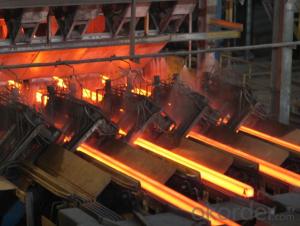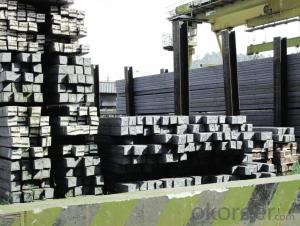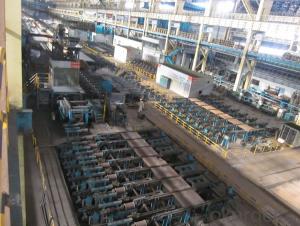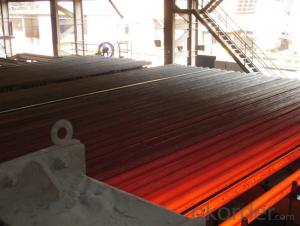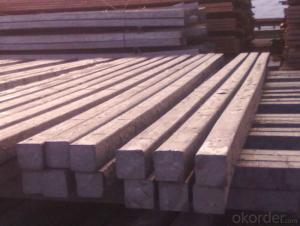Hot Rolled Steel Billet 3SP Standard 125mm
- Loading Port:
- Shanghai
- Payment Terms:
- TT OR LC
- Min Order Qty:
- 100 m.t.
- Supply Capability:
- 10000 m.t./month
OKorder Service Pledge
OKorder Financial Service
You Might Also Like
Structure of Hot Rolled Steel Billet 3SP Standard 125mm

Description of Hot Rolled Steel Billet 3SP Standard 125mm
Prepainted Rolled steel Coil is a kind of coated steel coil/sheet. With the cold rolled steel of different strength and thickness as substrate, it is produced through applying Al-Zn coat on both faces by hot dip process. In its coating, Al accounts for about 55%, Si 1.6%, while the remaining is Zn. Aluminum zinc coils enjoys both the physical protective feature and durability of Al and the electrochemical protective property of Zn. And its surface has bright silver color and regular embossed-like figure, which are highly decorative. RAL Scale Z35 Prepainted Rolled Steel Coil for Construction Roofing

Main Feature of Hot Rolled Steel Billet 3SP Standard 125mm
1.Corrosion resistance: It mainly depends on the zinc protection. When the zinc being worn,
2. Heat resistance: steel sheet has excellent heat resistance, can withstand high temperatures over 300 centigrade, and is similar with aluminized steel high temperature oxidation resistance. It often used in chimney pipes, ovens, fluorescent lighting device and the device cover.
3. Heat reflective: Galvanized steel plate heat-reflective high rate is twice as galvanized steel, often used to make insulation materials. RAL Scale Z35 Prepainted Rolled Steel Coil for Construction Roofing
Applications of Hot Rolled Steel Billet 3SP Standard 125mm
1. Construction and building: roofing; ventilating duct; handrail; partition panel;etc.
2. Electric appliance: refrigerator; washing machine; refrigerator; DVD;etc.
3.Transportation: oil tank; gas tank;road sign; etc.
4.Agriculture constructions :barn; etc.RAL Scale Z35 Prepainted Rolled Steel Coil for Construction Roofing
5.Others:vending machine; game machine; auto parts spare parts etc.
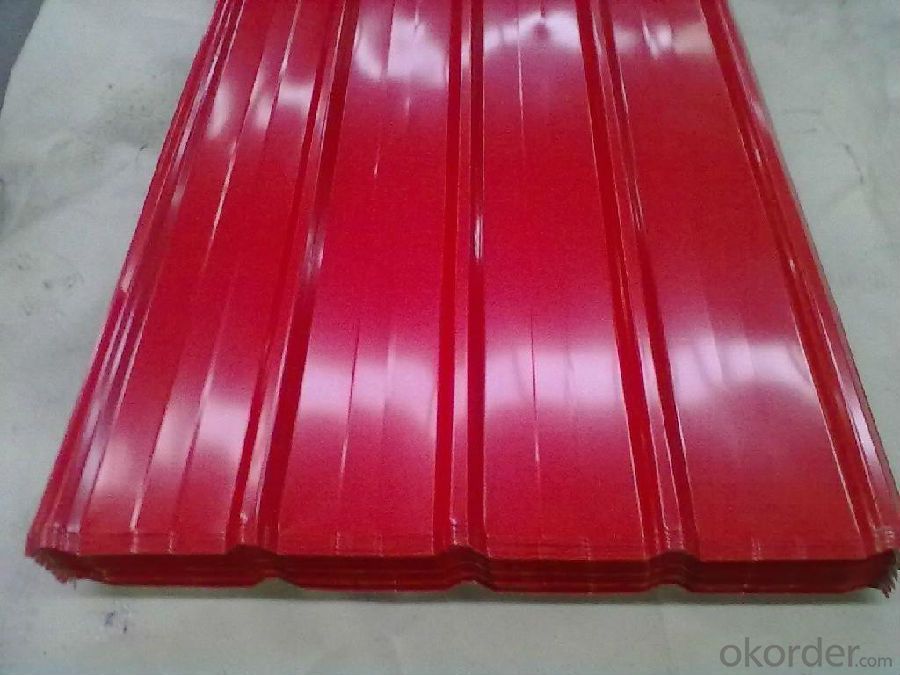
Specifications of Hot Rolled Steel Billet 3SP Standard 125mm
Product | Hot Rolled Steel Billet 3SP Standard 125mm |
Material Grade | SGCC / SGCH / DX51D+AZ, etc |
Thickness | 0.5-3.0mm |
Width | 700-1500mm |
Tolerance | Thickness: +/-0.02mm , Width:+/-2mm |
Zinc-coating | AZ30-150g/m2 |
Technique | Raw material: Hot rolled steel coil --> Cold rolled_>hot dipped galvalume |
Surface | Dried, Chromated, Unoiled,RAL Scale Z35 Prepainted Rolled Steel Coil for Construction Roofing |
Spangle | Regular spangle , small spangle, zero spangle |
ID | 508MM 610MM |
Coil weight | 25MT max |
Export package | Cardboard inner sleeves, Waterproof paper, galvanized steel covered and steel strip packed |
FAQ of Hot Rolled Steel Billet 3SP Standard 125mm
We have organized several common questions for our clients,may help you sincerely:
1. What is the minimum order quantity ?
Our MOQ is 100 mt for each size each specification. Usually we can offer discount if can buy large QTY once. RAL Scale Z35 Prepainted Rolled Steel Coil for Construction Roofing
2. How long can we receive the product after ordering?
Our general delivery time is 30 days after confirmation, but so some special orders, we have offer special delivery time
3. How to guarantee the quality of the products?
We have established the international advanced quality management system ,every link from raw material to final product we have strict quality test;We resolutely put an end to unqualified products flowing into the market. At the same time, we will provide necessary follow-up service assurance.
4. What is the payment?
We accept T/T, L/C
- Q:What are the factors that affect the mechanical properties of steel billets?
- The mechanical properties of steel billets are influenced by several factors. These factors include the chemical composition, heat treatment, microstructure, grain size, processing conditions, surface condition, and environmental factors. 1. Chemical composition: The mechanical properties of steel billets are determined by the levels of carbon, manganese, silicon, and other alloying elements in the steel. These elements impact the strength, hardness, and ductility of the billets. 2. Heat treatment: By controlling the temperature and duration of heating and cooling, the mechanical properties of steel billets can be significantly altered. Techniques like annealing, quenching, and tempering can enhance the hardness, toughness, and overall strength of the steel. 3. Microstructure: The mechanical properties of steel are greatly influenced by its microstructure, which is determined by factors like cooling rate and alloying elements. Different phases, such as ferrite, pearlite, and martensite, affect the strength, ductility, and toughness of the billets. 4. Grain size: The size and distribution of grains in the steel billets have an impact on their mechanical properties. Finer grain sizes generally result in improved strength and toughness, while larger grain sizes may lead to reduced mechanical properties. 5. Processing conditions: The mechanical properties of steel billets are influenced by the processing conditions during production, such as temperature and rate of deformation. Techniques like rolling, forging, and extrusion affect the grain structure and overall mechanical behavior of the steel. 6. Surface condition: The mechanical properties of steel billets can be significantly affected by the surface condition, including the presence of defects like cracks, voids, or surface contamination. Surface defects act as stress concentration points and reduce the overall strength and integrity of the steel. 7. Environmental factors: The mechanical properties of steel billets can be influenced by environmental conditions like temperature, humidity, and exposure to corrosive substances. Corrosion can decrease strength and structural integrity, while high temperatures can cause softening or thermal degradation of the steel. Considering these factors is crucial in the design and manufacturing of steel billets to ensure that the desired mechanical properties are achieved for specific applications.
- Q:How are steel billets marked for identification?
- Steel billets are typically marked for identification using a variety of methods such as stamping, engraving, or laser marking. This allows for important information like the grade, size, and batch number to be permanently etched onto the surface of the billet, ensuring easy identification and traceability throughout the manufacturing process.
- Q:How are steel billets used in the production of industrial valves?
- Steel billets are used in the production of industrial valves as they serve as the raw material for shaping and forming various valve components, such as bodies, bonnets, stems, and discs. Through machining, forging, and welding processes, the steel billets are transformed into the required shapes and sizes, ensuring the strength and durability of the valves.
- Q:What are the different types of steel billet packaging?
- There are several different types of steel billet packaging that are commonly used in the industry. 1. Bundles: Bundles are one of the most common types of packaging for steel billets. In this method, several billets are tightly bound together using steel straps or wire rods. This helps to secure the billets and prevent any movement or damage during transportation or storage. 2. Wooden crates: Wooden crates are another popular packaging option for steel billets. These crates are usually made of sturdy wooden materials and are designed to provide maximum protection to the billets. They are typically reinforced with steel bands or straps to ensure the billets remain secure. 3. Steel cages: Steel cages or racks are commonly used for packaging steel billets. These cages are made of steel and are designed to hold multiple billets at once. They provide a sturdy and secure packaging solution and allow for easy handling and transportation. 4. Plastic wrapping: In some cases, steel billets may be wrapped in plastic film or shrink wrap to provide protection against moisture and corrosion. This method is often used when the billets are being stored or transported in a controlled environment. 5. Custom packaging: Depending on specific requirements, steel billets may also be packaged in custom-made containers or packaging solutions. These can include specialized crates, boxes, or containers designed to fit the dimensions and weight of the billets, ensuring maximum protection during transportation and storage. Overall, the choice of steel billet packaging depends on factors such as the size and weight of the billets, transportation method, and desired level of protection. Each type of packaging has its own advantages and is chosen based on the specific needs of the industry and the customer.
- Q:What are the different methods of steel billet surface treatment?
- There are several methods of steel billet surface treatment that are commonly used in the industry. These methods aim to enhance the surface properties of the steel billets, such as improving corrosion resistance, increasing hardness, and improving aesthetics. Some of the most common methods of steel billet surface treatment are: 1. Pickling and Passivation: This process involves the removal of impurities and oxide layers from the steel surface using acid solutions. After pickling, the steel is passivated to create a protective layer that prevents future corrosion. 2. Shot Blasting: Shot blasting is a mechanical surface treatment method that involves the use of high-speed steel shots or grits to bombard the surface of the billets. This process removes scale, rust, and other contaminants, resulting in a clean and uniform surface. 3. Hot-Dip Galvanizing: In this process, the steel billets are immersed in a bath of molten zinc, which forms a protective coating on the surface. This method provides excellent corrosion protection, making it suitable for outdoor applications. 4. Electroplating: Electroplating involves the deposition of a thin layer of metal, such as chrome or nickel, onto the steel surface using an electric current. This method improves the appearance of the steel, enhances corrosion resistance, and can also provide better wear resistance. 5. Powder Coating: Powder coating is a popular method of surface treatment, especially for aesthetic purposes. It involves applying a dry powder onto the steel surface and then curing it through heat, resulting in a durable and attractive finish. 6. Painting: Painting is another common method used for surface treatment. The steel surface is first cleaned and primed before applying a suitable paint system. This method not only enhances the appearance but also provides protection against corrosion and environmental factors. 7. Nitriding: Nitriding is a heat treatment process that involves the diffusion of nitrogen into the steel surface. This method improves the hardness, wear resistance, and fatigue strength of the billets. These are just a few of the various methods of steel billet surface treatment available. The choice of method depends on the specific requirements of the application, desired properties, and budget considerations.
- Q:How are steel billets used in the manufacturing of automotive chassis?
- Due to their strength and durability, steel billets are essential in the production of automotive chassis. Obtained through casting molten steel into a rectangular shape, they serve as the raw material for various automotive components, including the chassis. The automotive chassis provides structural support and stability to the vehicle, bearing the load and impacts during driving. The main frame of the chassis, made from steel billets, forms the backbone of the vehicle. To shape the steel billets, they are heated and passed through rolling mills. This process increases their strength and rigidity, making them suitable for the demanding conditions of the chassis. The billets are then welded together using techniques like arc welding or laser welding to create the chassis structure. This ensures a solid and reliable connection that can withstand the stresses and forces experienced during operation. Using steel billets in the manufacturing of automotive chassis offers several advantages. Steel's high tensile strength allows it to withstand heavy loads and impacts without deforming or failing. It also has excellent fatigue resistance, ensuring the structural integrity of the chassis under repeated stress cycles. Additionally, steel is readily available, cost-effective, and easily recyclable, making it a preferred choice for automotive manufacturers. Its excellent corrosion resistance is crucial for vehicles exposed to various weather conditions and road environments. In conclusion, steel billets are crucial for manufacturing automotive chassis as they provide the necessary strength and durability. Shaped and welded together, they form the main frame of the chassis, ensuring the safety and performance of the vehicle under demanding driving conditions.
- Q:What are the different types of mechanical property testing methods for steel billets?
- Some different types of mechanical property testing methods for steel billets include tensile testing, hardness testing, impact testing, and fatigue testing. Tensile testing measures the strength and ductility of the material by applying a pulling force until it breaks. Hardness testing measures the resistance of the material to penetration or indentation. Impact testing evaluates the material's ability to absorb energy under high rates of loading. Fatigue testing assesses the material's resistance to failure under cyclic loading conditions.
- Q:How are steel billets used in the production of gears?
- Gears are manufactured using steel billets as the raw material. These billets are semi-finished steel products with a square or rectangular cross-section. They are heated and hot-rolled to shape them into gears. The first step in gear production with steel billets is selecting the appropriate steel grade. This grade should have specific mechanical properties, such as high strength, toughness, and wear resistance. These properties ensure that the gears can withstand the demanding conditions they will face during operation. Once the steel billets are chosen, they are heated to a high temperature to make them malleable and easier to shape. This heating process, known as hot working, allows the steel to be deformed without cracking or fracturing. The billets are then passed through rollers to shape them into gears with the desired dimensions. After the initial shaping, the gears may undergo additional machining operations to refine their shape and improve precision. These operations, like milling, grinding, or hobbing, remove excess material and create the final gear profile. By doing so, they ensure that the gears meet the required tolerances and have smooth surfaces for optimal performance. Once the gears are machined to the desired specifications, they may undergo heat treatment processes like quenching and tempering. These processes enhance the gears' mechanical properties by increasing their hardness and strength. This makes the gears more durable and resistant to wear. Overall, steel billets are essential in gear production as they serve as the starting material for the manufacturing process. Through heating, shaping, machining, and heat treatment, steel billets are transformed into high-quality gears that are strong, durable, and precisely engineered to meet the specific requirements of different mechanical applications.
- Q:How is the quality of steel billets ensured during production?
- The quality of steel billets is ensured through various measures implemented during the production process. Here are some key factors that contribute to ensuring the quality of steel billets: 1. Raw Material Selection: The quality of steel billets starts with the selection of high-quality raw materials, such as iron ore, coal, and scrap metal. These materials undergo rigorous testing to ensure they meet the required specifications and standards. 2. Melting and Refining: Steel billets are produced through the process of melting and refining the raw materials. During this stage, advanced technologies and equipment are used to control the temperature and chemical composition, ensuring uniformity and consistency in the final product. 3. Continuous Casting: The molten steel is then poured into a continuous casting machine, where it solidifies into billet form. Continuous casting allows for precise control over the cooling process, resulting in billets with uniform dimensions and internal structure. 4. In-line Inspection: Modern production facilities incorporate in-line inspection systems that continuously monitor and analyze the quality of the steel billets during the production process. These systems use various techniques such as laser measurement, ultrasonic testing, and magnetic particle inspection to detect any defects or abnormalities. 5. Heat Treatment: After the initial production, steel billets may undergo heat treatment processes such as annealing or quenching to enhance their mechanical properties and eliminate any residual stresses. These treatments are carefully controlled to achieve the desired results and improve the overall quality of the billets. 6. Testing and Quality Control: Steel billets undergo comprehensive testing to ensure they meet the required standards and specifications. This includes various mechanical and chemical tests, such as tensile strength, hardness, and chemical composition analysis. Additionally, non-destructive testing methods like ultrasonic testing and X-ray inspection are employed to detect any internal defects or flaws. 7. Traceability and Documentation: Throughout the production process, comprehensive documentation is maintained to track each batch of steel billets, from the raw materials used to the final testing results. This ensures traceability and provides a record for quality control purposes. By implementing these measures and following strict quality control procedures, steel manufacturers can ensure that the steel billets produced meet the required quality standards and are suitable for further processing and use in various industries.
- Q:What are the common surface defects in steel billets?
- Some common surface defects that can be found in steel billets include: 1. Scale: This is a thin layer of oxide that forms on the surface of the billet during the hot rolling process. It can appear as a flaky or rough texture and is caused by the reaction of the steel with oxygen in the air. 2. Cracks: Cracks can occur due to a variety of reasons, such as improper cooling or excessive stresses during the manufacturing process. These cracks can be either longitudinal or transverse and can greatly affect the structural integrity of the billet. 3. Pitting: Pitting refers to small depressions or cavities that can form on the surface of the billet. It is often caused by localized corrosion or reactions with impurities in the steel. 4. Lamination: Lamination defects occur when there are layers or sheets of non-metallic inclusions within the steel billet. These inclusions can weaken the billet and affect its mechanical properties. 5. Surface porosity: Surface porosity refers to the presence of small voids or bubbles on the surface of the billet. It can be caused by gas entrapment during the solidification process or by improper casting techniques. 6. Inclusions: Inclusions are non-metallic substances that can be present in the steel billet. These can include oxides, sulfides, or other impurities, and can affect the billet's mechanical properties. It is important to identify and address these surface defects in steel billets as they can impact the quality and performance of the final product. Various inspection techniques, such as visual inspection, ultrasonic testing, or magnetic particle testing, can be employed to detect and eliminate these defects to ensure the production of high-quality steel products.
1. Manufacturer Overview |
|
|---|---|
| Location | |
| Year Established | |
| Annual Output Value | |
| Main Markets | |
| Company Certifications | |
2. Manufacturer Certificates |
|
|---|---|
| a) Certification Name | |
| Range | |
| Reference | |
| Validity Period | |
3. Manufacturer Capability |
|
|---|---|
| a)Trade Capacity | |
| Nearest Port | |
| Export Percentage | |
| No.of Employees in Trade Department | |
| Language Spoken: | |
| b)Factory Information | |
| Factory Size: | |
| No. of Production Lines | |
| Contract Manufacturing | |
| Product Price Range | |
Send your message to us
Hot Rolled Steel Billet 3SP Standard 125mm
- Loading Port:
- Shanghai
- Payment Terms:
- TT OR LC
- Min Order Qty:
- 100 m.t.
- Supply Capability:
- 10000 m.t./month
OKorder Service Pledge
OKorder Financial Service
Similar products
New products
Hot products
Related keywords
